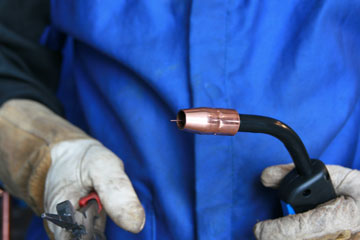MIG Welding Techniques
About Instructor

OVERVIEW
Using proper MIG welding techniques in roll cage fabrication with mild steel is critical to achieving weld quality, and many race cars must pass certification with qualified welds. Chris Jarman, owner of Michigan-based fab shop Eliminator Kustoms, shows how to weld a roll cage with a Millermatic® 212 Auto-Set™ MIG welder and discusses the various tube angles involved — 90 degrees, 45 degrees and 30 degrees. Jarman also demonstrates proper pull and drag welding methods, and how you can decide which method you should use in MIG welding.
In the previous lesson, we reviewed proper safety attire, voltage and amperage, and equipment preparation — please review that lesson here.
Wire selection
For steel, there are two common wire types. Use an AWS classification ER70S-3 for all-purpose welding. Use ER70S-6 wire when more deoxidizers are needed for welding on dirty or rusty steel. As for wire diameter, .030-inch diameter makes a good all-around choice for welding a wide range of metal thicknesses in home and motorsports applications. For welding thinner material, use a .023-inch wire to reduce heat input. For welding thicker material at higher total heat levels, use .035 inch (or .045-inch wire if it is within your welder’s output range).
Gas selection
- A 75 percent argon/25 percent carbon dioxide blend (also called 75/25 or C25) works as the best all purpose shielding gas for carbon steel. It produces the least amount of spatter, best bead appearance and won’t promote burn-through on thinner metals.
- 100 percent CO2 provides deeper penetration, but also increases spatter and the bead will be rougher than with 75/25.
Wire stick-out
 Stick-out is the length of unmelted electrode extending from the tip of the contact tube and it does not include arc length. Generally, maintain a stickout of 3/8 inch and listen for a sizzling bacon sound. If the arc sounds irregular, one culprit could be that your stickout is too long, which is an extremely common error.
Stick-out is the length of unmelted electrode extending from the tip of the contact tube and it does not include arc length. Generally, maintain a stickout of 3/8 inch and listen for a sizzling bacon sound. If the arc sounds irregular, one culprit could be that your stickout is too long, which is an extremely common error.
Push or pull?
- The push or forehand technique involves pushing the gun away from (ahead of) the weld puddle. Pushing usually produces lower penetration and a wider, flatter bead because the arc force is directed away from the weld puddle.
- With the drag or backhand technique (also called the pull or trailing technique), the welding gun is pointed back at the weld puddle and dragged away from the deposited metal. Dragging typically produces deeper penetration and a narrower bead with more buildup.
When MIG welding mild steel, you can use either the push or pull technique, but note that pushing usually offers a better view and enables you to better direct wire into the joint.
Now watch the video to learn about travel angle, work angle, flat position, horizontal position, vertical positions, and overhead position!
Visit MillerWelds.com for more insights!






